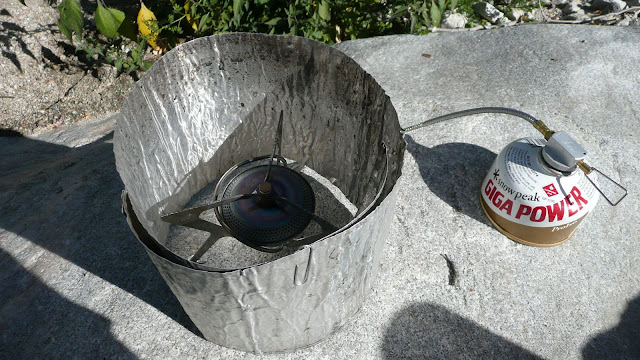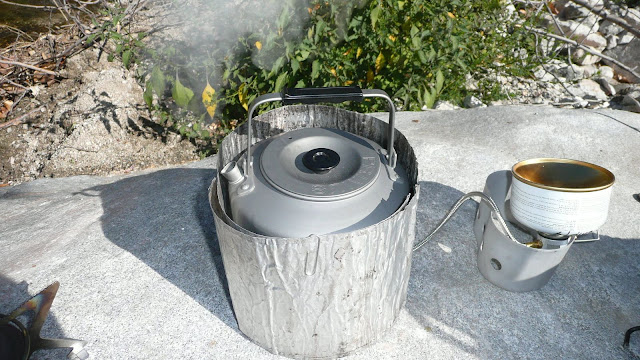This week's stove is the MSR WindPro.

The WindPro is a remote canister stove, meaning that the stove uses a canister of gas that is attached to the stove via fuel hose rather than being directly attached to the stove. Here you can see the stove and the gas canister as well as the fuel hose that connects them.

What's that you say? You think the WindPro looks just like last week's stove, the Simmerlite? Well you're right about that (Simmerlite, top; WindPro, bottom).

But take a look at the connectors. That's what distinguishes the two. The Simmerlite runs on white gasoline, a liquid fuel, and the WindPro runs on canister gas.

So, what's the big deal about it being a remote canister stove? Well, on the more common upright type of canister stove, the burner mounts directly on the canister. In other words, you have a very hot flame very close to a very flammable gas. If you use a windscreen around the burner, you will deflect heat toward and trap heat around the canister. Heat + flammable gas = bad. Very bad. Generally it's not a good idea to use a windscreen with an upright type canister stove unless a) you really know what you're doing and b) are extremely diligent about constantly monitoring the temperature of the tank via the "ouch" test (if the canister is hot enough to make you say "ouch," that's WAY too hot; TURN IT OFF IMMEDIATELY). If you don't have a wind screen around your stove, on a windy day you could quite literally go through an entire tank of gas without ever bringing a pot of water to boil.
Enter the remote canister stove. If you put a windscreen around the burner, the canister, which is some distance away, will not be affected. In fact, since the windscreen is between the canister and the flame, it's not only OK to use a windscreen, it's actually safer to operate the stove with a windscreen. A windscreen not only makes your stove more efficient it also protects the canister.
Note in this photo how the windscreen sits between the canister and the burner, protecting the flame AND protecting the canister.

Add to that the fact that remote canister stoves have a much lower center of gravity and tend to be much more stable. Particularly with a larger pot on top of a small canister stove, the arrangement can be quite "tippy," and your dinner may wind up spilled.
So, why doesn't everyone just use a remote canister stove? I mean who wants to waste gas that they've just packed up a mountainside or risk spilling their dinner? Well, first there's the up front cost. Remote canister stoves can often be double the price of upright canister stoves. Second, there's the weight. An upright canister stove uses the canister itself for support; it has no legs. Also, an upright canister has no hose. The hose and legs of a remote canister stove all add weight. Upright canister stoves are typically much lighter than remote canister stoves. Then lastly there's compactness. The legs and hose of a remote canister stove take up space.
In short, as in much of life, which stove is the better stove is a series of trade offs. Which stove is the better stove for a given individual or a given use depends largely on the style of that individual, the conditions (wind, weather, elevation, etc.), and on the way in which the stove will be used.
For larger groups (and therefore for larger pots), the more stable remote canister stove is the better choice.
For areas prone to wind, a remote canister stove is the better choice.
For smaller groups or soloists, an upright canister stove will work just fine.
For those on a budget, the upright canister stove is the logical choice.
For fair weather, why not just take a lightweight upright canister stove? Why carry more than you need?
But before you make your decision, there's yet another advantage to a remote canister stove, a big advantage: liquid feed mode. First, let me be clear: Not all remote canister stoves can operate in liquid feed mode. In order to function properly and safely, a gas stove must have vaporized gas (not liquefied gas like the gas in the canister). In liquid feed mode, to turn the liquefied gas in the canister into vaporized gas, a stove must have a generator (aka a "pre heat loop"). The generator is an area where liquefied gas is exposed to high heat such that the liquefied gas vaporizes (turns from a liquid into a gas). If your remote canister stove does not have a generator, do not attempt to feed it liquefied gas.
How do I know if my stove has a generator? Take a look at this photo.

Note the silver colored tube that proceeds from the left side of the burner around the front of the burner and up the right hand side of the burner. This is the generator.

Now, take at look at the top left side of the burner in the above photo. If you look closely, you can see the generator, and you can see that the flames from the burner are actually hitting the generator. Needless to say, the liquefied gas flowing through the generator is being exposed to high heat and does vaporize.
Well, that's very nice, but why should I care that I can use liquid feed mode? Answer: Cold weather. Your stove needs vaporized gas. In cold weather, gas doesn't vaporize properly. In liquid feed mode you rely not on the weather but on the flame to vaporize your gas. In other words, you can get the vaporized gas your stove needs even in weather that is quite cold. Depending on the design of your stove, you may be able to operate your stove in liquid feed mode in temperatures down to -10F/-23C. By contrast, an upright canister stove isn't much good in temperatures lower than 20F/-6C.
Well, this liquid feed mode sounds very interesting, but as a practical matter, how do I go about it? Well, you invert (turn upside down) the canister. After inversion, the valve is at the bottom of the canister, and the pressure in the canister forces liquefied gas out the bottom of the canister. Before you start, it's best to put something heavy (like a pot of water) on the stove so the stove won't tip over as you invert the canister. The recommended way to use a stove in inverted canister mode is to start the stove in normal mode, let the stove get hot, turn down the flame to low, and then invert the canister, keeping the canister low the entire time. The stove will surge a bit when you invert the canister because of the physics of a liquid turning rapidly to gas. Keeping the canister low and turning the flame down low help keep the surge to a minimum. Leaning the canister against something will keep the canister inverted (see photo).

Now, here's our WindPro, happily chugging away in inverted canister mode, and, as you can clearly see, she has handily passed the "tea test."

Ah! I see that breakfast is served, so you'll have to excuse me.

I thank you for joining me on another adventure in stoving.
HJ
Some summary information:
What's good about it?
For a remote canister stove, it is light and compact.
It has a generator (pre heat loop) so it can be used in inverted canister liquid feed mode.
The fuel hose is long and flexible which facilitates using the stove in inverted canister liquid feed mode.
It's perfectly safe with a wind screen.
In liquid feed mode, it will work well in low temperatures, perhaps even subzero temperatures. Note: I'm not trying to be wishy-washy. I just haven't done the field testing needed for me to feel confident in proclaming this a viable option in subzero weather.
It's a canister stove. Gas is really convenient.
What's bad about it?
The WindPro uses relatively heavy steel canisters. Lighter canisters like the Powermax canister are available.
As with all canister stoves, you have the problem of what to do with empty canisters. In some places there are some recycling programs, but recycling is not environmentally free. There is some cost to the environment for delivering gas in convenient little canisters.
Inverted canister mode is a little "fiddly." There are other gas stoves specifically designed for liquid feed mode that you don't have to fiddle with as much.
The pot supports are a little slidey. They could be a little more grippy.
Overall, the MSR WindPro is a good light weight winter capable stove.










0 comments:
Post a Comment